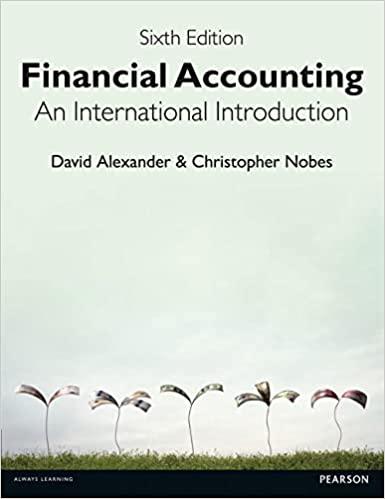Question
1. Which of the following is FALSE? Unlike financial accounting, managerial accounting provides data for internal users. b. Unlike financial accounting, managerial accounting is required
1. Which of the following is FALSE?
Unlike financial accounting, managerial accounting provides data for internal users.
b. Unlike financial accounting, managerial accounting is required by law.
Unlike managerial accounting, financial accounting is subject to GAAP.
Unlike managerial accounting, financial accounting emphasizes the past.
2. Which of the following is FALSE?
Factory overhead consists of all indirect manufacturing costs.
Period costs are also known as nonmanufacturing costs or operating expenses.
Conversion costs consist of direct labor and factory overhead.
Direct costs are costs that are difficult to trace directly to a specific cost object.
3. Which of the following is FALSE?
A predetermined target cost that should be achieved is known as a standard cost.
Costs that have already been incurred are known as sunk costs.
Costs that remain constant in total regardless of changes in activity are known as variable costs.
Expected future costs that will differ between alternatives are known as relevant costs.
4. Depreciation on a machine used to manufacture soda is an example of
Period Cost
Direct Materials
Prime Cost
Conversion Cost
5. The cost of shipping a product to a customer is an example of
Direct Labor
Factory Overhead
Selling Expense
General & Administrative Expense
6. Which of the following is TRUE?
When you purchase materials, your Work In Process Inventory increases.
When you incur labor costs, your Finished Goods Inventory increases.
When you allocate overhead to products, your Work In Process Inventory decreases.
When you sell your products to customers, your Finished Goods Inventory decreases.
7. Which formula would you use to compute Cost of Goods Manufactured?
Beginning Raw Materials Inventory + Purchases Ending Raw Materials Inventory
Direct Materials Used + Direct Labor + Factory Overhead
Beginning Work In Process Inventory + Total Manufacturing Costs for Current Period Ending Work In Process Inventory
Beginning Finished Goods Inventory + Cost of Goods Manufactured Ending Finished Goods Inventory
8. Which formula would you use to compute Cost of Goods Sold?
Beginning Raw Materials Inventory + Purchases Ending Raw Materials Inventory
Direct Materials Used + Direct Labor + Factory Overhead
Beginning Work In Process Inventory + Total Manufacturing Costs for Current Period Ending Work In Process Inventory
Beginning Finished Goods Inventory + Cost of Goods Manufactured Ending Finished Goods Inventory
9. Which of the following statements is FALSE?
Total fixed costs may change between relevant ranges.
Total fixed costs are constant within each relevant range.
Variable cost per unit is constant within each relevant range.
Total mixed costs are constant within each relevant range.
10. As volume increases,
fixed cost per unit increases
variable cost per unit increases
fixed cost per unit decreases
variable cost per unit decreases
Step by Step Solution
There are 3 Steps involved in it
Step: 1

Get Instant Access to Expert-Tailored Solutions
See step-by-step solutions with expert insights and AI powered tools for academic success
Step: 2

Step: 3

Ace Your Homework with AI
Get the answers you need in no time with our AI-driven, step-by-step assistance
Get Started


